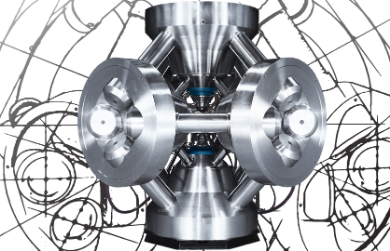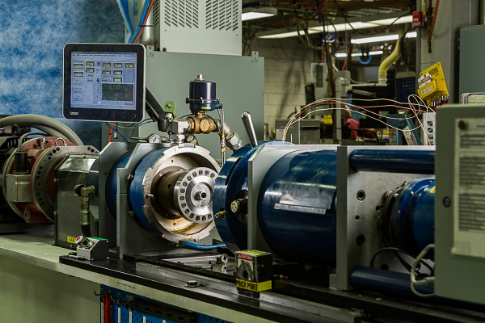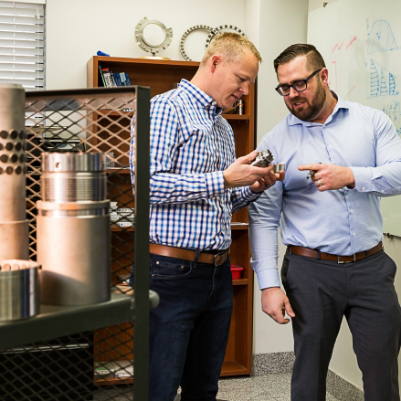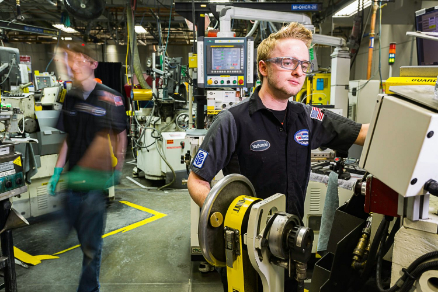US Synthetic Research and Development
State-of-the-art
Research and development at US Synthetic
A dedicated group of experienced scientists, engineers, and technicians drives US Synthetic’s efforts to perfect and enhance our existing diamond solutions—and develop innovative new technology and designs for the future.

Our scientists with more than 50 years of combined diamond research experience lead the US Synthetic research and development efforts. A separate team of application engineers works directly with customers to develop custom diamond solutions that make the best possible use of the latest technology. These engineers have years of experience with PDC design and working with bit companies. A staff of experienced technicians constantly evaluates and tests new products in the laboratory, so the product is tested and ready for application in the field.
All of these experienced professionals work in state-of-the-art research and testing facilities. This includes a full metallurgical lab, an advanced computer-aided design center, and a sophisticated testing lab. These facilities allow our scientists and engineers to:
- Create and optimize new diamond cutter and bearing designs using the latest solid modeling software.
- Model and analyze the thermal and mechanical performance of PDC cutters and bearings under simulated drilling conditions using finite element analysis tools.
- Quickly build prototype cutters and bearings in a dedicated R&D environment.
- Evaluate cutters and bearings using scanning acoustic microscopy (C-SAM), optical and scanning electron microscopy, and metallurgical analysis.
- Monitor and improve cutter and bearing performance with abrasion, impact resistance, and vertical turret lathe (VTL) testing.
At US Synthetic, all of these advanced research, development, and testing capabilities come together to produce the most advanced, innovative, and effective PDCs in the world.

High-pressure high-temperature technology
Diamond sintering requires the application of extreme heat and pressure. Typically, diamond is sintered at a temperature of around 1400°C (2550°F). At room pressure, these extreme temperatures would cause the diamond to revert to graphite. Maintaining extremely high pressure during the sintering process allows the diamond to remain in its natural form (see figure). This typically requires pressures of around 60 kbar (nearly 1,000,000 psi)—the equivalent of a 240 km (160 mile) high column of granite.
To achieve these extremely high temperatures and pressures simultaneously, we use proprietary cubic press technology. The cubic press consists of six large pistons, each of which is capable of supplying several thousand tons of force. Each piston pushes on a small tungsten carbide anvil, which in turn compresses a cubic pressure cell that contains the raw materials (carbide and diamond crystals). As soon as the cubic press reaches the desired pressure, electric current flows through a resistance heater embedded in the pressure cell to generate the required high temperatures. These conditions are maintained long enough to ensure complete diamond-to-diamond bonding of the individual crystals.



PDC drilling applications
PDCs were first introduced decades ago as a replacement for natural diamonds. These early natural diamond cutters lacked toughness, were generally limited to the softest drilling applications, and required very specialized bit designs and carefully controlled drilling parameters. Over the years, aggressive innovation and improvements to the process have steadily increased the durability, impact resistance, and abrasion resistance of Polycrystalline Diamond Cutters.
Today’s PDCs are effective in shale, limestone, and sandstone formations. Over time, the PDC-drillable zone will continue to grow and expand (see figure). For example, our teams are frequently cutting crystalline rocks for extended periods in a laboratory environment—and we are working hard to extend these capabilities to an operating environment.
Today, PDC enhanced bits provide the fastest, most durable and most cost-effective drilling.

Resource Library
Diamond Technologies Education
Our History
ChampionX has been serving customers for over a century. See our vast company history that dates back to the 1800’s.
Our Solutions
Discover all that ChampionX has to offer with our visual interactive tool.
Resource Library
Filter through our latest product literature to find case histories, product brochures, news, and more.
Why work with us
7,300+
Employees
60+
Countries
40+
Manufacturing Locations
400+
Scientists and Technologists





